|
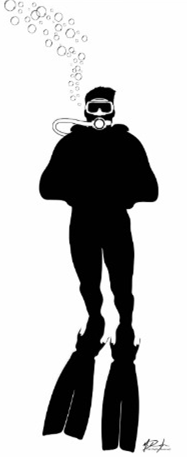

Dive Log
Back to

Back to

|
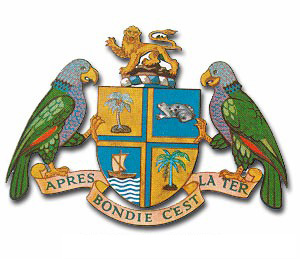
Dominica, West Indies
August, 1989
"In the wild grandeur of its towering
mountains, some of which rise to five thousand feet above the
level of the sea, in the majesty of its almost impenetrable
forests, in the gorgeousness of its vegetation, the abruptness
of its precipices, the calm of its lakes, the violence of its
torrents, the sublimity of its waterfalls, Dominica stands
without rival not in the West Indies, but I should think
throughout the whole island catalogue of the Atlantic and
Pacific Combined"
W. Palgrave 1876
My John McDonald collection of five Travis
McGee novels was dusted off and equipment hastily packed for our
trip to the watery island of Dominica, West Indies. Flight
and hotel arrangements were left to our travel agent Linda who
looks with some trepidation to the challenge of booking our dive
trips. Linda had to work with a company in Minnesota
called "Go Diving" to make the final connections.
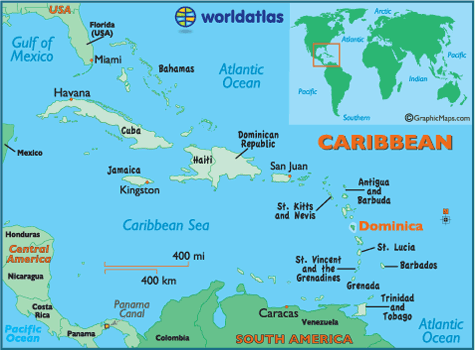
I was teaching a summer semester of
Biology and wasn't able to get away until the first week in
August. That's pushing into hurricane season. A week
before we left, a hurricane had swept through several islands of
the West Indies, serious enough to vacate some of the smaller
islands. On August 4th, Dad and I once again set our on an
adventurous treck to a remote hole in the ocean not one of our
friends had ever heard of.
|
A bit of history...

Dominica, officially the Commonwealth of
Dominica, is an island country in the Lesser Antilles region of
the Caribbean Sea, south-southeast of Guadeloupe and northwest
of Martinique. Christopher Columbus named the island after the
day of the week on which he spotted it: Sunday (dies Dominica
in Latin), November 3, 1493. In the hundred years following,
Dominica remained isolated. At the time it was inhabited by the
Kalinago people, (Island Caribs), and as European powers entered
the region, more refugees settled there after being driven from
surrounding islands, eventually driving the Spanish settlers
away. France had a colony on Dominica for several years,
importing African slaves to work on plantations, at which time
the Antillean Creole language developed. France formally ceded
possession of Dominica to Great Britain in 1763. Great Britain
established a small colony on the island in 1805.
Dominica
has been nicknamed the "Nature Isle of the Caribbean" for its
unspoiled natural beauty. It is the youngest island in the
Lesser Antilles, still being formed by geothermal-volcanic
activity, as evidenced by the world's second-largest hot spring,
Boiling Lake. The island features lush mountainous rainforests,
and is the home of many rare plants, animals, and bird species.
There are xeric areas in some of the western coastal regions,
but heavy rainfall occurs inland. The island has 365 rivers. The
Sisserou parrot (also known as the Imperial Amazon), is found
only on Dominica and is the island's national bird. It is
featured on the national flag. Dominica's economy is heavily
dependent on tourism and agriculture. |
Our flight plans called
for us to fly from Omaha to Chicago then on to San Juan, Puerto
Rico via American Airlines. The flights were back-to-back
which made the long flight a little less tiresome. The
flight from Chicago to San Juan included a film called "Her
Alibi" with Tom Seleck. It reminded me of several episodes
of Magnum PI in which Magnum played a fictitious detective in an
unbelievable situation.
In San Juan, we changed
from America to Liat (Leeward Islands Air Transport). We
came to learn that the airlines was subsidized by the government
and therefore had a tendency of being unpredictable. From
San Juan we flew Liat to Antigua where we overnighted at the
Sugar Mill.
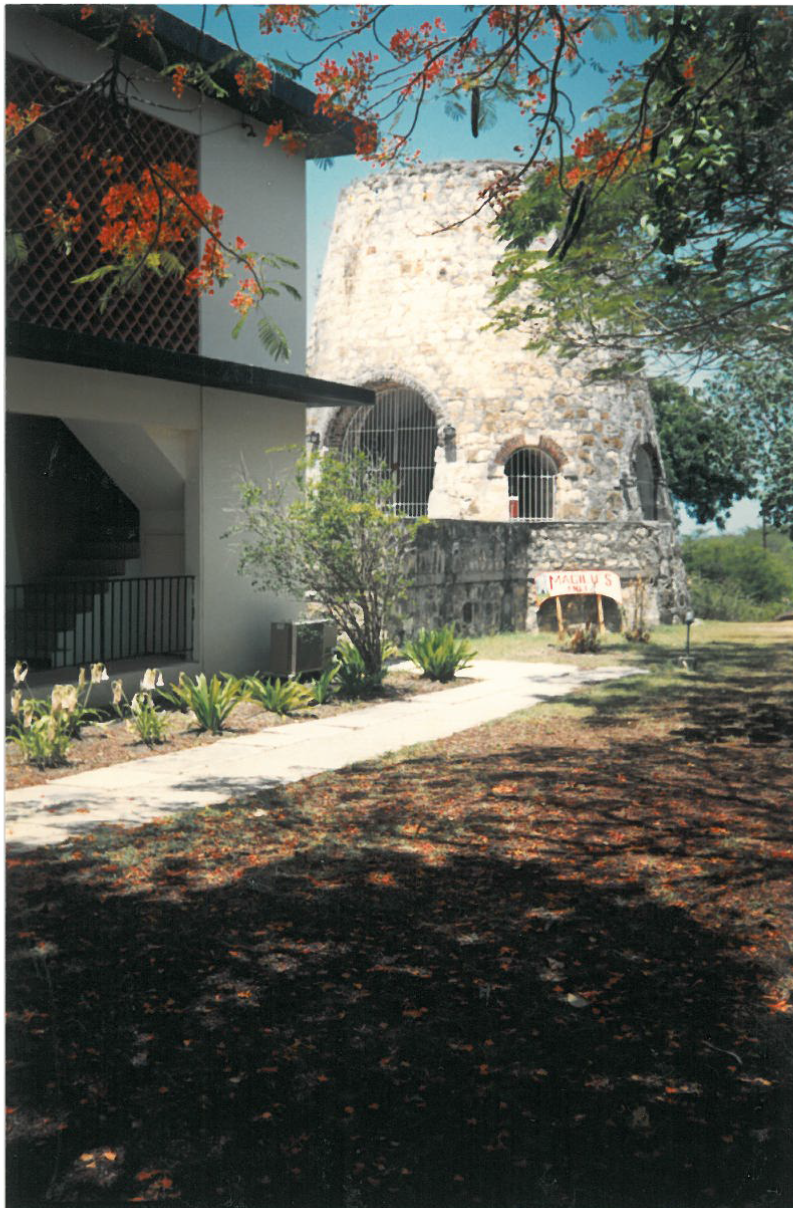 |
Centuries before, ships came to Antigua for other
reasons. The island is dotted with the remnants of
sugar mills once used to boil, extract sugar, and export
its products. The sugar mills are conical towers
20-30 feet tall of thick stone. The mill at the
hotel had been refitted as a bar and its iron cauldron
was cast into the building's foundation.
The entrance to the hotel was gained
by way of a pot-holed road leading to an open courtyard.
After a quick check in, we were shown to our room - a
comfortable lodging for the evening. After of a
supper of breaded veal we heaved our tired bones into
bed for an early flight the next morning.
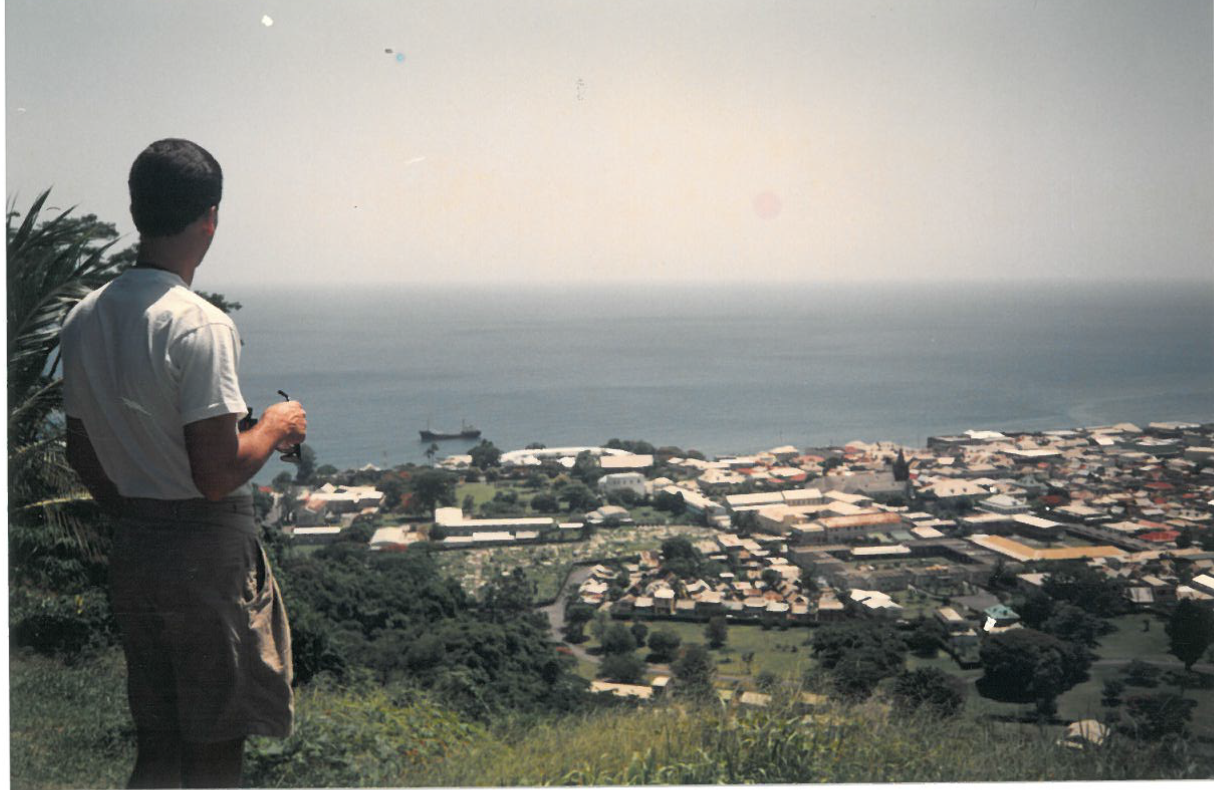 |
The airport was only a two-mile ride from
the hotel. We were scheduled to depart Antigua at 8:55 AM
in a twin prop that seated about 30 with luggage and supplies.
From Antigua our small craft made a stop on Guadeloupe; a more
populated island than I expected. The stop was only to let
some passengers off and others on. We landed at 11:00 AM
and went through immigration and customs at Guadeloupe.
From there, we flew to Dominica and landed at R.C. Bird Field
(concourse B) at the southern end of the island. It was a
short airstrip that required a sharp bank and rapid decent on
the approach.
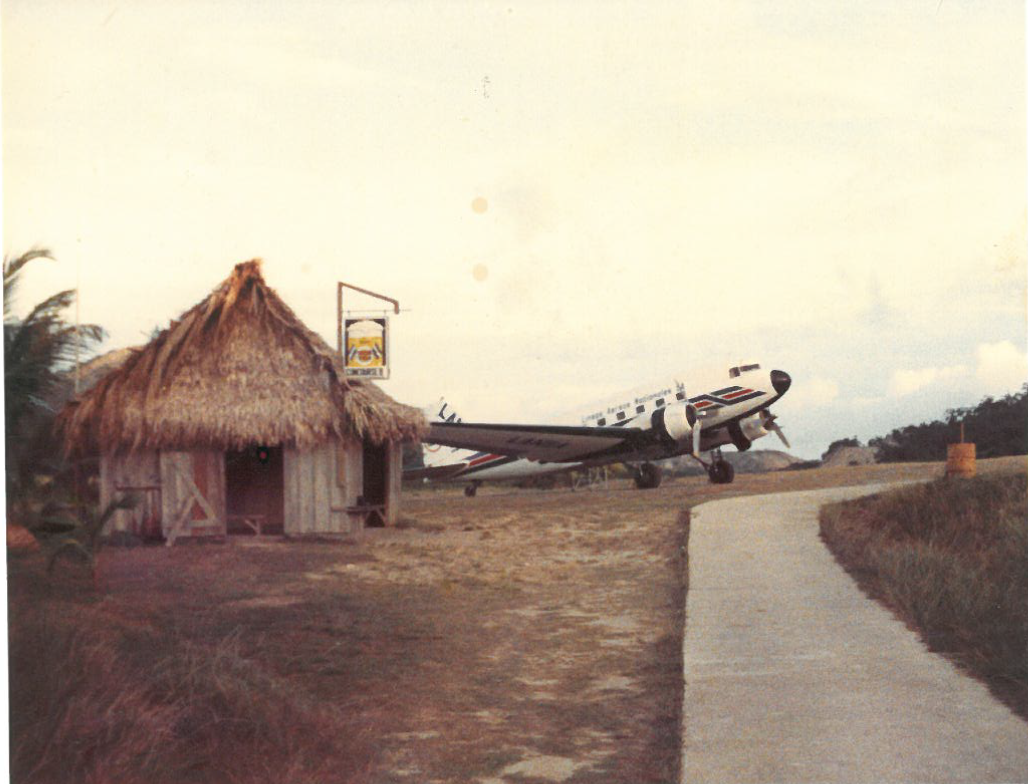
I kid you not. This is the runway; a
grass shack with a sign "Concourse B." Makes you wonder,
where is concourse "A"? A hotel representative was waiting
to taxi us to the Anchorage Inn.
The islanders do all things slow but two;
talk and drive. These people drive with unnerving speed
over roads a car-and-a-half wide with a trench on one side.
New York cabbies could take a lesson from these drivers.
We wound our way through the bustling town of Roseau and pulled
up to the lobby. Nothing impressive; an elongated concrete
structure painted white to reflect the intense sun.
A thin native girl checked us in - no
instructions - called for a boy to take our suitcases to our
room and that was our welcome. The first room we were
taken to was occupied. A second room key was brought and
we were taken to room 221...on the third floor. The north
wall was shuttered with wood louvers, an air conditioner ran
loudly as we slept. There was one single and one double
bed in the room with flimsy mattresses, a small table between
the beds, and a lamp. The bathroom was rather large by
island standards with a shower, toilet, and shelves for
clothing. We quickly learned that we would rarely have hot
water - sometimes lucky to have water at all - and that what
water did flow would last long. Oh well, there was a pool.
At lunch, we dined on trout, beans, and
had our first taste of breadfruit. The breadfruit was
tasteless; certainly not worth creating conditions for mutiny on
the Bounty unless you were forced to eat it regularly. We
came to find that our lunches were not included in our package
and therefore we quickly changed our eating habits to something
more economical.
Having the afternoon free, we chose to
take a short tour. A taxi was called and Winston - our
driver - took us to the Botanical Gardens (which left a lot to
be desired), past the factory where Rose Lime Juice is made, and
up to a scenic lookout over the city. Winston was a black
man in his fifties, very articulate and knowledgeable of the
island. When asked whether or not the island was better of
with its independence than under British rule, he replied it was
all relative. After leaving, the British had not prepared
the island for the inevitable turmoil that would follow.
With no incentive for the youth to stay, after a free education
they left for other islands taking the future of Dominica with
them. Winston felt a shift in the education system was
needed; getting away from the technical aspects and leaning more
towards agricultural training.
Dinner was scheduled to begin at 7PM but
when we climbed the stairs to the open dining room, we were told
that dinner would be at 8 downstairs; they were expecting a
large group. We took a table for two nearest those set for
the smorgasbord. The group that came to dinner was
composed mostly of women in their late fifties and over; a few
with their spouses. Although I didn't bother to ask, I
inferred that it was a church women's organization. We
dined on a variety of salads, rice, fish, chicken, and mixed
fruit for desert.
The evening's entertainment - and I use
the term loosely - was billed as a native band. It turned
out to be a quartet; one played a long piece of bamboo, one
played a button accordion (his job was to play the melody, which
he did over, and over, and over), one played a large hoop drum,
and the youngest played a long-handled shaker with a corrugated
side filled with something that went pa-chunk when it was shook.
We didn't stay long and wondered back to our room to read before
dropping off to sleep.
We woke to take breakfast at 7AM - French
toast and juice - and went back to the room to prepare our
equipment for the first dive. We met at the dive shop in
the hotel at 9. It was a shack next to the bar and
equipped with new rental equipment and a compressor to fill
tanks, but little else. At previous dive operations, the
first dive is the checkout. Not so here. Our gear
was carried down to a strafed-hulled twenty foot wood/fiberglass
boat with twin 200 Mercury motors on the stern. No canopy.
No deck. No fresh water rinse tank. Just a place to
sit. So off Dad and I went with Jerry the boat hand and
David our Dive Master.
Jerry was the younger of the two blacks;
in his early twenties if that. Relatively short but
muscular with a birth mark on his left cheek and a smile and
personality of gold. David was much taller and thinner.
he had been Dive Master for the Guest House next door but had
had a falling out with the owner. I still question his
experience and ability to chart our dives.
We always dove the southern end of the
island around Scott's Head. It was said that the northern
end gets too much rain making the visibility poor. Our
first morning dive was to be off Scott's Head; a dive we would
attempt several times but never complete. This is the
point where the Atlantic currents meets the Caribbean currents.
After suiting up, I rolled off into a jet stream. I was
immediately swept aft and luckily managed to grab the safety
line. The current was so strong that I could have skied on
the line. I pulled myself hand-over-hand back to the boat
and shed my weights and tank before crawling in. We chose
another dive site.
We rounded the point of land to the
Atlantic side to make our first dive in that ocean. The
waters were rougher and while preparing for the dive, I found
myself getting sea sick. As long as I could see the
horizon I was fine; it was when I looked down that I got into
trouble. Once in the water I was fine. Our plan was
to dive 90 feet for 30 minutes.
We found all of the reefs to be fishy with
large schools of small fish, but very rarely did we see any
large angels or parrot fist we found at other sites. There
were a large number of spotted drum - varying in age from
juvenile to adult - and an unbelievable number of arrowhead
crabs. Dominica would be a macro-photographer's dream.
The majority of fish were small.
When the dive was completed, we handed our
weights to Jerry and slipped out of our tanks and BC.
Freed from this burden, with a flip of our fins we could propel
ourselves into the boat. We had a surface time of one hour
before our next dive.
Our second dive was in an area where
sulfur hot springs bubble up from the shallows. Since our
sites had no names, we felt Champaign Reef was appropriate
because of the bubbles. The average depth here was a
shallow 30 feet. We saw a pair of squid, large sea
biscuits, anemones, and a large eel buried up to its gills in
the sand.
Our afternoon was spent in a most relaxing
manner lounging by the pool watching the preparation for the
construction of a new boat dock. Since our lunch wasn't
part of the package, we dined on sandwiches and tea. Back
to the construction. Enormous steel pipes - five in all,
with a chisel point welded to one end were lowered through a
guide affixed to a barge with a crane. The crane then used
a narrow solid tube to drive the pipes into the sand and coral.
Over the course of the week, we watched the natives bail out the
tubes after they had filled with water, slip rods into the top
of each and pour concrete, slip a wood platform over the tubes,
add more support rods, and fill the entire form with concrete.
Before we left, they had removed the forms and the dock was
nearly complete.
That evening we dined on pumpkin soup,
rock Cornish game hens, sweet potatoes, breadfruit, beats, and a
lemon lime banana pie. What was unusual about our
out-of-water time was that it was free of bugs. We had
anticipated a deluge of no-see-ums and mosquitoes, but our Deet
sat unopened all week.
On August 8th, I made my 101st dive
amassing over 75 hours of dive time. Not an impressive
record for some, but for us it was an achievement. The
dive was at Scott's Head in the morning and it started in
current almost impossible to swim against. It was an
effort to get to the anchor line and I was worried that Dad
might not make it. But once we dropped over the edge of
the reef and were out of the current, the dive was excellent.
The strong current kept the reef clean. The anemones were
huge.
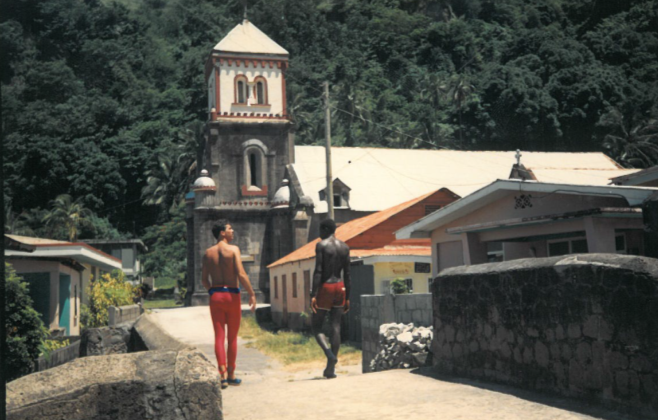
We dove Seufriere Bay later that
morning seeing several eels, sand dollars, and more
spotted drum. There were a number of small eels,
one of which I was able to coax out by brushing its tail
with my finger.
The evening meal began with
pumpkin soup and shrimp cocktail. The main course
was grilled tuna. Dad had goat with side servings
of rice, cabbage, and the potato-like dachene.
|
Seufriere Bay was guarded by the old fortress of Scott's
Head. Our surface time was spent touring the town
of Seufriere; a poor yet spotlessly clean town.
The Church of Your Baptism was lovely. Its
rough-hewn stone cathedral shape boasted a vaulted
ceiling, native frescos and adorned with leaded stained
glass windows. The church and its furnishings were
at least 100 years old and survived Hurricane David in
1979 with little damage save the steeple had to be
rebuilt. As thick as the walls were, I'm sure that
it will be there for another century.
There were also the remains of a
gigantic lime factory with its massive rusting water
wheel and abandoned walls of stone. The village
survived by fishing and its crops of bananas and
coconut.
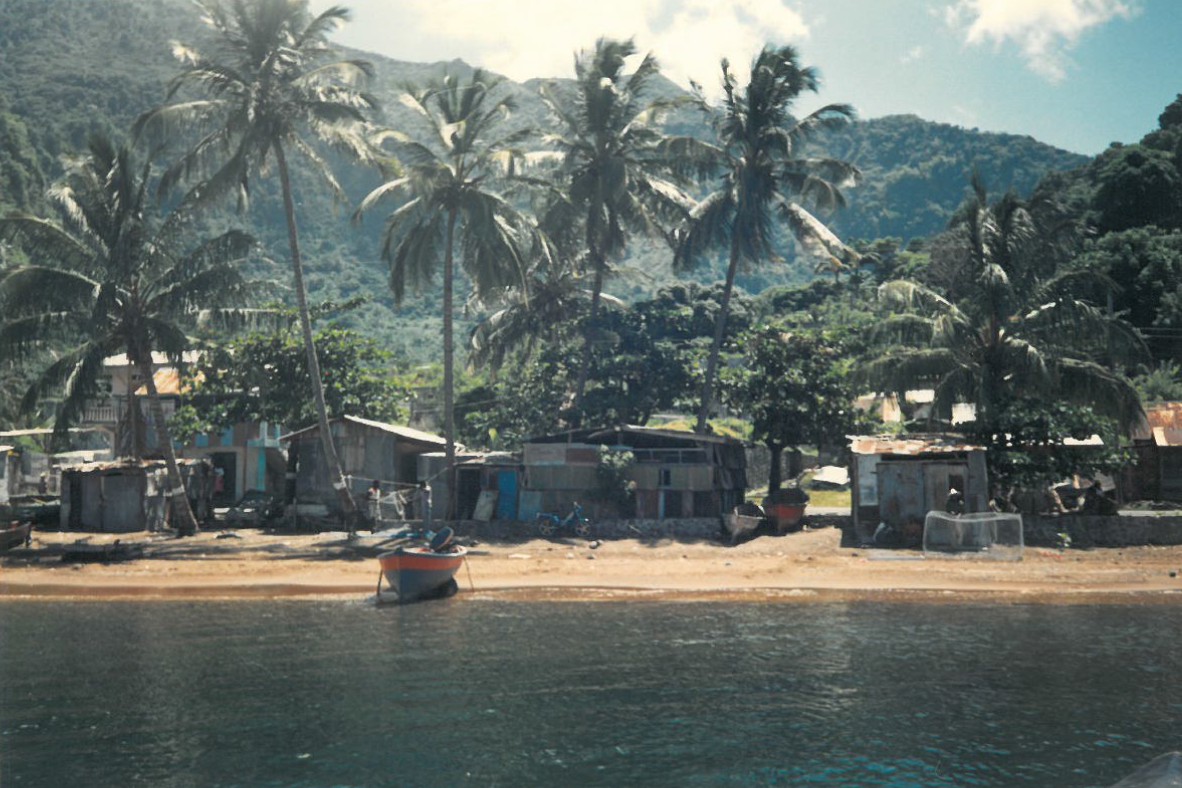 |
The next day we toured the island.
We were told to be in the lobby around 8:30. We put on our
hiking shorts and tennis shoes. I grabbed the binoculars
and Dad took the camera and bug spray (just in case).
While we were waiting, a tour group of seven men and women from
Italy (who spoke no English) were shown around the hotel.
We were told that they would be joining us for the tour.
Our guide was a young black man named Danny who told Dad and I
to ride up front with him. Lucky for us that we did.
Our tour bus was a Ford pickup whose bed had benches built over
each fender well and meagerly padded. I'm sure the Italian
guests were expecting something a bit more plush.
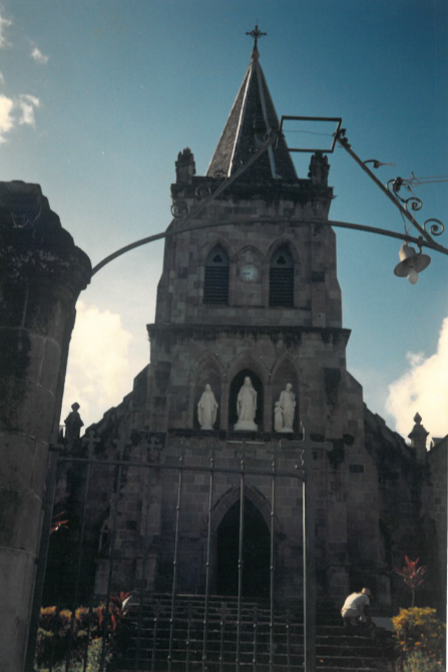 |
We
began with a trip through Roseau where we stopped at a
Catholic church built in 1854. Much larger and
more elaborate than the church in Seuferie Bay, this
classic example of gothic architecture was beautiful.
There were four rows of wooden pews on a beautiful
inlaid floor. A children's choir was practicing in
the loft over the doorway. The leaded stained
glass windows were old and lovely. The murals in
each arm of the church and at the altar were superbly
painted. There were the usual figures and an
elaborate high altar. We
continued our tour through the botanical gardens and
then on to the lookout we had visited with Winston.
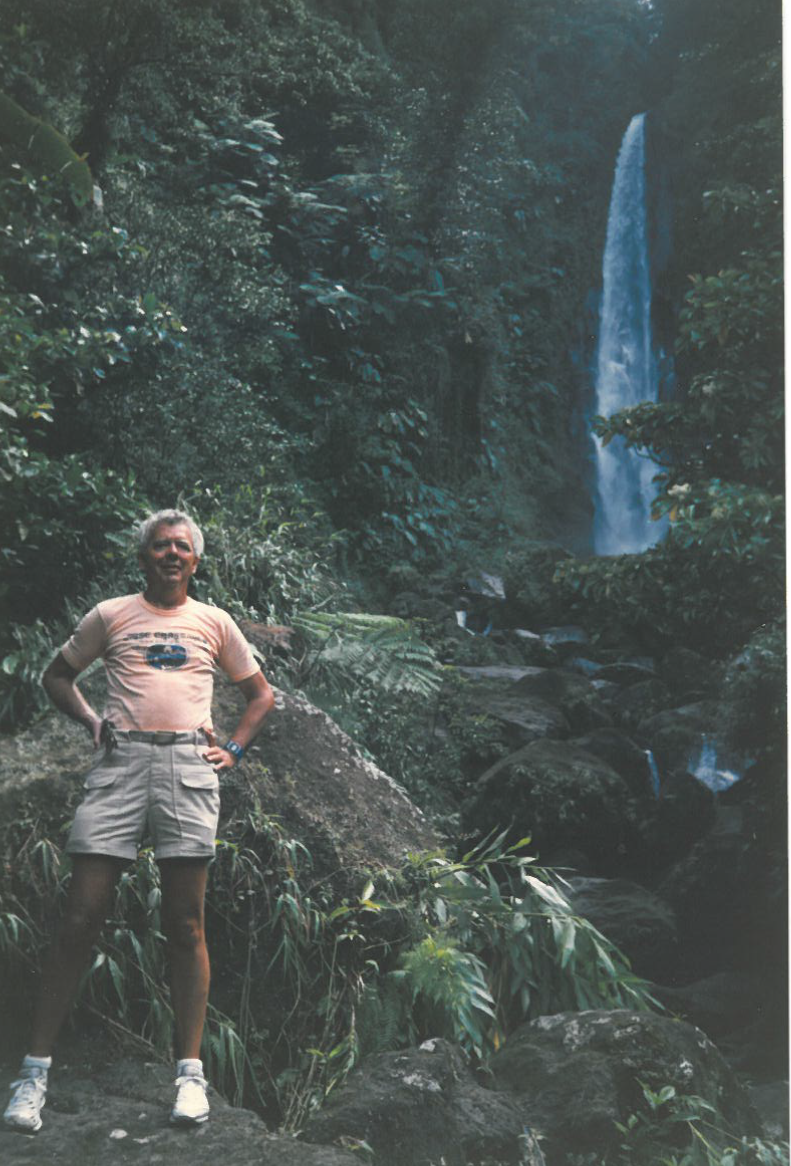 |
Our next destination was
Trafalgar Falls. It was a winding road up
the mountain over twisting roads. The Ford
was parked at the power station below the falls.
It was a brief and easy want to the falls.
They were twin falls; the smaller to the left
was the male, the falls with the larger mouth
was the female - their words not mine. At
the top of the falls, hundreds of feet up and a
hefty hike up Mt. Macque, is a fresh-water lake.
On the way back to the hotel,
a young native boy told Danny of a boiling
stream a short walk from the road. It was a hot,
long walk through tickets of banana crops and
forests to a stream quite literally boiling from
the escaping gas of the volcano. Only the
young boy, Danny, Dad, myself, and two Italians
made the trip.
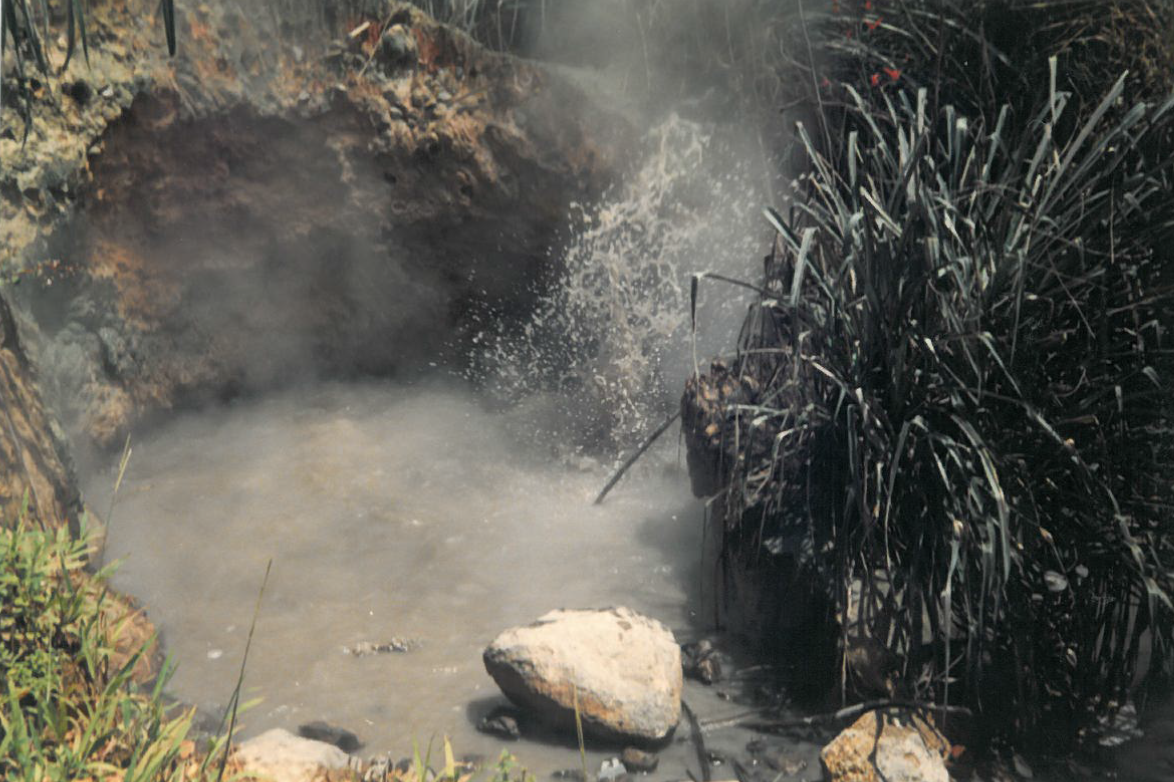 |
|
Our trip continued in the Ford over more
winding roads towards the interior of the island and the Emerald
Pool. Along the way it began to rain and of course the
truck didn't have a canopy. Luckily it stopped and on we
went. Emerald Pool was a national park; well maintained
and easy to get to. It was a short hike into the forest
where a waterfall pooled before continuing down the mountain.
The pool was at the bottom of Mourne Trios Pitas. The
water was cool and no one wanted to brave going in.
We had lunch at the entrance to the park
dining on chicken, salad, fruit, rice, and an extremely potent
rum punch. Each glass got a little smooooother.
We continued on the same road up and down
the mountain slopes to the eastern side of the island to stop at
the Caribe Indian Reservation - the last reservation for the
once vast tribe of native islanders. The Caribe are short
in stature, stocky, muscular build, coppery skin, and far more
attractive facial characteristics than their black neighbors.
They have a classic Mayan look. They were not big enough
for the labors expected of them by the Europeans, so African
slaves were brought in.
Danny stopped the truck at several huts
selling weavings and other crafts. I bought a wife leader
(Chinese finger trick) and a bracelet for five Caribbean dollars
($2.50 US). The reservation was spotless. Although
extremely poor, their homes were brightly painted with neat
gardens of cannas and paradise plants. The Italians found
very little of interest in the stop.
The drive back was through the central
portion of the island. More winding roads and the threat
of heavier rain. The Italians had to be back at the
airport (Cane Field) by 4:00. No more had we pulled in
when the skies opened up and it began to poor. Inside the
airport, the group voiced their complaints. I'm sure they
didn't recommend this trip to their countrymen, but Dad and I
found the tour fascinating and well worth the time.
That night - before supper - we asked that
the hotel confirm our flight back to Antigua. We got a
call in our room from the front desk telling us that Liat didn't
have a record of our reservation and that we would have to go to
the airport office the next afternoon. That was the start
of an aggravating flight home. That same day, a young
couple arrived at the hotel. They joined us the next
morning for a dive. The two dives were along the wall of
Seuferie Bay. Of all our dives on this trip, those two
dives were the worse. We assumed that it was because of
the heavy rains the day before. The young man, Eric, was a
lieutenant in the Special Forces of the California Police.
His wife, Geri, and he were both competent divers and friendly
people. Our last dive was named Pinnacle Reef; a cloudy
but lovely wall dive.
After lunch we had Danny dive us to the
airport. Sure enough, after we found someone to help us,
we learned that we were not on the flight list. We were
told that our flight was full and that we would have to take an
earlier flight the following morning scheduled to depart
Melville Airport at the other end of the island.
That evening's meal was depressing.
We felt that we had been robbed of two dives since we had
planned to dive before flying back to Antigua. On top of
that, we never did get our night dive in and then there was a
mix-up over whether or not lunch was included in our package.
We settled our account that night and voiced our complaints with
the desk clerk. The manager was not in.
Our flight out of Melville was at 10AM
which meant being there at 9:00. It was a two hour drive
to the airport so after a quick breakfast we waited for our
taxi. At least the hotel paid for the taxi to the airport.
One taxi took us to Rosseau where we were transferred to a
smaller mini-van. it was just Dad and I, the driver, and a
native airplane pilot. The ride was as close to a Grand
Prix as I ever want to come. As previously mentioned, the
roads were narrow, hair-pin turns, and with a shear drop on one
side and a trench on the other. Our driver managed an
average speed of 65 through this course. We braced
ourselves for the most white-knuckled trip we've ever taken.
We had several near misses including one near escape with a
Mercedes truck filled with bananas - it even shook our driver.
We arrived on time to an empty Melville
Airport. Our flight was on a larger DC-7; since the runway
was much larger. But the flight was late which then would
make our flight to San Juan also late; we had to run in San Juan
to catch our flight.
Back in Antigua again, we lounged around
an empty pool, played a game of pool, and then ate an early
dinner. Our flight was early the next morning and although
we got there more than an hour ahead, the lines were
unbelievably long. We still had not gotten to the counter
when the scheduled departure came; we had to run to the plane.
In San Juan, customs took longer than usual. The flight
was late and again we were running in the concourse. We
were the last to board and had no assigned seats, so they put us
in first class. The was the first and only time we ever
rode first class.
Chicago was just as bad. We had to
transfer from one concourse to another and then our direct
flight to Omaha was cancelled. We were to take a later
flight to Des Moines and then on to Omaha. We called ahead
to let Mom know we would be a bit late. It was a tiring
trip.
Back to

Back to

|